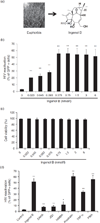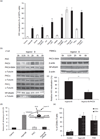Reactivation of HIV latency by a newly modified Ingenol derivative via protein kinase Cδ-NF-κB signaling
- PMID: 24804860
- PMCID: PMC4922310
- DOI: 10.1097/QAD.0000000000000289
Reactivation of HIV latency by a newly modified Ingenol derivative via protein kinase Cδ-NF-κB signaling
Abstract
Objective: Although HAART effectively suppresses viral replication, it fails to eradicate latent viral reservoirs. The 'shock and kill' strategy involves the activation of HIV from latent reservoirs and targeting them for eradication. Our goal was to develop new approaches for activating HIV from latent reservoirs.
Design: We investigated capacity of Ingenol B (IngB), a newly modified derivative of Ingenol ester that was originally isolated from a Brazilian plant in Amazon, for its capacity and mechanisms of HIV reactivation.
Methods: Reactivation of HIV-1 by IngB was evaluated in J-Lat A1 cell culture model of HIV latency as well as in purified primary CD4 T cells from long-term HAART-treated virologically-suppressed HIV-infected individuals. The underlining molecular mechanisms of viral reactivation were investigated using flow cytometry, RT-qPCR and chromatin immunoprecipitation.
Results: IngB is highly effective in reactivating HIV in J-Lat A1 cells with relatively low cellular toxicity. It is also able to reactivate latent HIV in purified CD4 T cells from HAART-treated HIV-positive individuals ex vivo. Our data show that IngB may reactivate HIV expression by both activating protein kinase C (PKC)δ-nuclear factor kappa-light-chain-enhancer of activated B cells (NF-κB) pathway and directly inducing NF-κB protein expression. Importantly, IngB has a synergistic effect with JQ1, a BET bromodomain inhibitor, in latent HIV reactivation.
Conclusions: IngB is a new promising compound to activate latent HIV reservoirs. Our data suggest that formulating novel derivatives from Ingenol esters may be an innovative approach to develop new lead compounds to reactivate latent HIV.
Conflict of interest statement
There are no conflicts of interest to declare for all authors.
Figures






References
-
- Macal M, Sankaran S, Chun TW, Reay E, Flamm J, Prindiville TJ, et al. Effective CD4+ T-cell restoration in gut-associated lymphoid tissue of HIV-infected patients is associated with enhanced Th17 cells and polyfunctional HIV-specific T-cell responses. Mucosal Immunol. 2008;1:475–488. - PubMed
-
- Finzi D, Hermankova M, Pierson T, Carruth LM, Buck C, Chaisson RE, et al. Identification of a reservoir for HIV-1 in patients on highly active antiretroviral therapy. Science. 1997;278:1295–1300. - PubMed
-
- Chun TW, Carruth L, Finzi D, Shen X, DiGiuseppe JA, Taylor H, et al. Quantification of latent tissue reservoirs and total body viral load in HIV-1 infection. Nature. 1997;387:183–188. - PubMed
Publication types
MeSH terms
Substances
Grants and funding
LinkOut - more resources
Full Text Sources
Other Literature Sources
Research Materials

